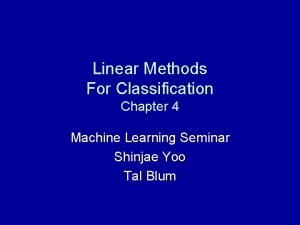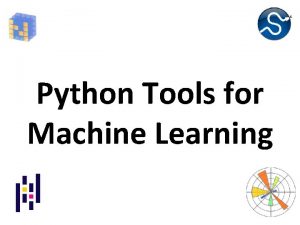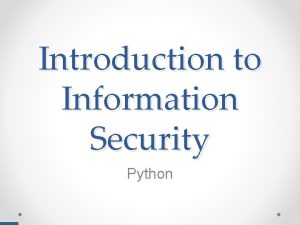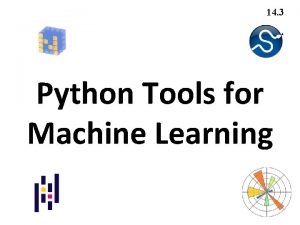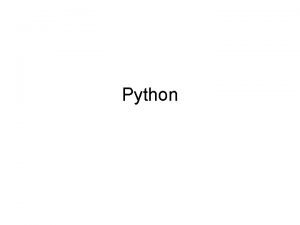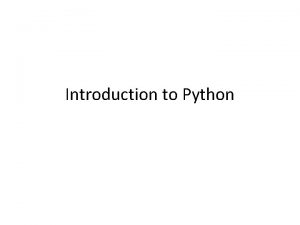Python Tools for Machine Learning Motivation Machine learning








![Num. Py Array Indexing, Slicing a[0, 0] # top-left element a[0, -1] # first Num. Py Array Indexing, Slicing a[0, 0] # top-left element a[0, -1] # first](https://slidetodoc.com/presentation_image_h/094e35003206b75a123a20c4cf43b330/image-9.jpg)




- Slides: 13

Python Tools for Machine Learning

Motivation • Machine learning involves working with data – analyzing, manipulating, transforming, … • More often than not, it’s numeric or has a natural numeric representation • Natural language text is an exception, but this too can have a numeric representation • A common data model is as a N-dimensional matrix or tensor • These are supported in Python via libraries

Motivation • Python is a great language, but slow compared to Java, C, and many others • Python packages are available to represent, manipulate and visualize matrices • We’ll briefly review numpy and scipy – Needed to create or access datasets for ML training, evaluation and results • And touch on pandas (data analysis and manipulation) and matplotlib (visualization)

What is Numpy? • Num. Py supports features needed for ML – Typed N-dimensional arrays (matrices/tensors) – Fast numerical computations (matrix math) – High-level math functions • Python does numerical computations slowly and lacks an efficient matrix representation • 1000 x 1000 matrix multiply – Python triple loop takes > 10 minutes! – Numpy takes ~0. 03 seconds

Num. Py Arrays Can Represent … Structured lists of numbers • • • • Vectors Matrices Images Tensors Convolutional Neural Networks

Num. Py Arrays Can Represent … Structured lists of numbers • • • Vectors Matrices Images Tensors Convolutional Neural Networks

Num. Py Arrays Can Represent … Structured lists of numbers • • • Vectors Matrices Images Tensors Convolutional Neural Networks

Num. Py Arrays, Basic Properties >>> import numpy as np >>> a= np. array([[1, 2, 3], [4, 5, 6]], dtype=np. float 32) >>> print(a. ndim, a. shape, a. dtype) 2 (2, 3) float 32 >> print(a) [[1. 2. 3. ] [4. 5. 6. ]] Arrays: 1. Can have any number of dimensions, including zero (a scalar) 2. Are typed: np. uint 8, np. int 64, np. float 32, np. float 64 3. Are dense: each element of array exists and has the same type
![Num Py Array Indexing Slicing a0 0 topleft element a0 1 first Num. Py Array Indexing, Slicing a[0, 0] # top-left element a[0, -1] # first](https://slidetodoc.com/presentation_image_h/094e35003206b75a123a20c4cf43b330/image-9.jpg)
Num. Py Array Indexing, Slicing a[0, 0] # top-left element a[0, -1] # first row, last column a[0, : ] # first row, all columns a[: , 0] # first column, all rows a[0: 2, 0: 2] # 1 st 2 rows, 1 st 2 columns Notes: – Zero-indexing – Multi-dimensional indices are comma-separated) – Python notation for slicing

Sci. Py • Sci. Py builds on the Num. Py array object • Adds additional mathematical functions and sparse arrays • Sparse array: one where most elements = 0 • An efficient representation only implicitly encodes the non-zero values • Access to a missing element returns 0

Sci. Py sparse array use case • Num. Py and Sci. Py arrays are numeric • We can represent a document’s content by a vector of features • Each feature is a possible word • A feature’s value might be any of: – TF: number of times it occurs in the document; – TF-IDF: … normalized by how common the word is – and maybe normalized by document length …

Sci. Py sparse array use case • Maybe only model 50 k most frequent words found in a document collection, ignoring others • Assign each unique word an index (e. g. , dog: 137) – Build python dict w from vocabulary, so w[‘dog’]=137 • The sentence “the dog chased the cat” – Would be a num. Py vector of length 50, 000 – Or a sci. Py sparse vector of length 4 • An 800 -word news article may only have 100 unique words; The Hobbit has about 8, 000

More on Sci. Py See the Sci. Py tutorial Web pages 13
 Lda machine learning python
Lda machine learning python Python memory leak tools
Python memory leak tools Formuö
Formuö Novell typiska drag
Novell typiska drag Nationell inriktning för artificiell intelligens
Nationell inriktning för artificiell intelligens Vad står k.r.å.k.a.n för
Vad står k.r.å.k.a.n för Varför kallas perioden 1918-1939 för mellankrigstiden
Varför kallas perioden 1918-1939 för mellankrigstiden En lathund för arbete med kontinuitetshantering
En lathund för arbete med kontinuitetshantering Kassaregister ideell förening
Kassaregister ideell förening Personlig tidbok för yrkesförare
Personlig tidbok för yrkesförare A gastrica
A gastrica Densitet vatten
Densitet vatten Datorkunskap för nybörjare
Datorkunskap för nybörjare Boverket ka
Boverket ka
